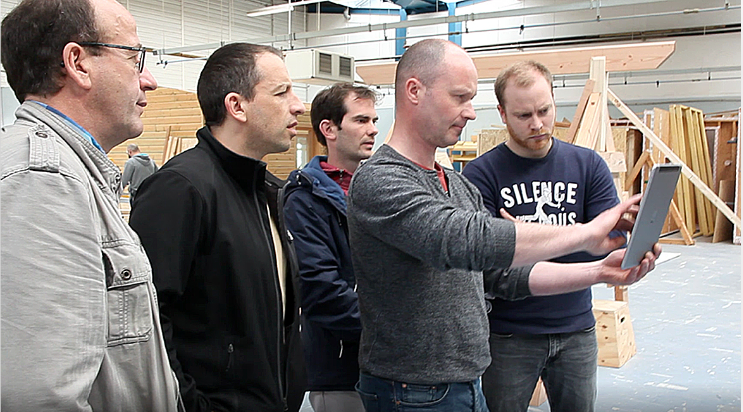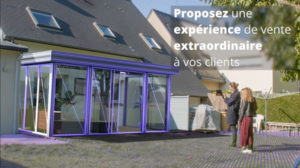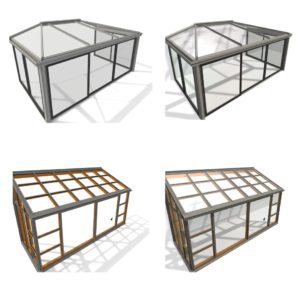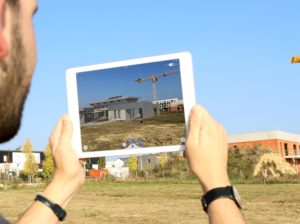Réalité Augmentée :
l'avenir de l'éducation

Dans cet article, nous explorerons la façon d’utiliser le développement de la Réalité Augmentée (RA) dans l’éducation et la formation professionnelle. Pourquoi, plus que n’importe quelle autre technologie, elle va jouer un rôle prépondérant dans ce secteur.
Les méthodes traditionnelles d’éducation telles que nous les connaissons font désormais parties du passé. Elles sont de plus en plus numérisées et tirées par les innovations technologiques.
En fait, la soi-disant EdTech, l’industrie des technologies de l’éducation, devrait atteindre 252 milliards de dollars d’ici 2021, avec une croissance annuelle de 17%. Le marché de la RA quant à lui devrait atteindre 60,55 milliards de dollars d’ici 2023.
De plus, d’ici 2025, deux milliards de la population mondiale seront constitués par la plus jeune génération : la génération Alpha, également connue sous le nom d’iGeneration. La génération Alpha sont des enfants nés entre 2010 et 2025.
Il s’agit de la première génération entièrement née au 21e siècle. Ces enfants sont considérés à ce jour comme le groupe démographique le plus technologique. Cette génération dite « Alpha » utilise naturellement la technologie, les smartphones, les tablettes et les ordinateurs. Ils n’ont pas connu la vie sans Internet ni les jeux vidéo. Certains d’entre eux vivent dans des maisons intelligentes et parlent à un assistant vocal intelligent tous les matins avant d’aller à l’école. Ils connaissent SpaceX et veulent vivre sur Mars un jour. Ces enfants sont nés avec des iPhones, des iPads et des applications. Ils ne savent pas ou ne peuvent même pas imaginer comment serait la vie sans eux.
Ainsi, parmi les tendances les plus importantes dans la EdTech, la réalité augmentée prend donc à juste titre une position de leader. Avec plus d’un milliard d’utilisateurs qui devraient rejoindre le mouvement d’ici 2020, elle ouvre un bassin d’opportunités pour les établissements d’enseignements, de formations et les entreprises.
En effet, les enseignants disposent désormais d’un outil très puissant : la réalité augmentée. La RA peut motiver et engager les étudiants à rendre le processus d’apprentissage plus rapide, plus amusant et plus efficace que jamais.
Qu'est-ce que la Réalité Augmentée
La réalité augmentée est le pont qui relie le monde réel avec le monde virtuel. Sa popularité augmente rapidement dans tous les secteurs, des filtres de médias sociaux aux interventions chirurgicales. Comme le suggère le mot « augmentée », la RA améliore ce que nous entendons, voyons et ressentons.
Nous faisons souvent face au manque de clarté des informations 2D dans notre monde en 3 dimensions. Là où les informations étaient affichées en 2D sur des manuels d’explications ou des écrans, la réalité augmentée nous permet de les voir en 3D dans notre univers physique.
Elle peut s’utiliser sur différents supports comme des tablettes, des smartphones et même des lunettes.
Il existe diverses technologies de réalité augmentée. Certaines sont basées sur des marqueurs, d’autres sans marqueurs, certaines sur de la projection et d’autres en superposées. Tout cela, rend la RA utile pour de nombreuses industries.
Utilisation de la réalité augmentée dans l'éducation et la formation : opportunités et défis
Fournir une expérience d’apprentissage engageante est primordial pour le succès de tout établissement d’enseignement, et en particulier, le succès de l’éducateur.
Les applications de réalité augmentée dans l’éducation offrent de nouvelles façons d’enseigner et d’apprendre, comblant le fossé entre le monde virtuel et le monde réel et peuvent même réconcilier certains métiers dits “traditionnels” avec les nouvelles technologies. Les avantages de la RA dans l’éducation sont de plus en plus reconnus par les chercheurs sur le sujet.
La réalité augmentée dans l’éducation peut servir à plusieurs fins. Elle aide les étudiants à acquérir, traiter et mémoriser facilement les informations. De plus, la RA rend l’apprentissage plus engageant et amusant.
La réalité augmentée n’est pas non plus limitée à un seul groupe d’âge ou niveau d’éducation et peut être utilisée aussi bien à tous les niveaux de scolarité ; de l’éducation préscolaire au lycée en passant par les formations professionnelles, ou même au travail.
Avantages de la réalité augmentée dans l’éducation :
- Matériel d’apprentissage accessible – n’importe quand, n’importe où. La réalité augmentée a le potentiel de remplacer les manuels papiers, les modèles physiques, les affiches, les manuels imprimés. Elle propose du matériel d’apprentissage portable et moins cher. En conséquence, l’éducation devient plus accessible et mobile.
- Aucun équipement spécial n’est requis. Contrairement à la réalité virtuelle, la réalité augmentée ne nécessite aucun matériel coûteux. Étant donné que 98% des adolescents (18-24 ans) et 95% des jeunes adultes (25-39 ans) possèdent actuellement un smartphone, les technologies de RA sont immédiatement disponibles pour une utilisation par la plus grande majorité du public cible.
- Plus grand engagement et intérêt des étudiants. L’apprentissage interactif et “gamifié” de la RA peut avoir un impact positif significatif sur les étudiants. Cela les maintient engagés tout au long de la leçon et rend l’apprentissage amusant et presque sans effort.
- Amélioration des capacités de collaboration. Les applications de réalité augmentée offrent de nombreuses opportunités de diversifier et de bouleverser les cours ennuyeux. Des leçons interactives, où tous les élèves sont impliqués dans le processus d’apprentissage en même temps, aident à améliorer les compétences de travail d’équipe.
- Un processus d’apprentissage plus rapide et plus efficace. La RA en éducation aide les élèves à obtenir de meilleurs résultats grâce à la visualisation et à une immersion totale dans le sujet projeté en taille réelle. Une image vaut mille mots, n’est-ce pas ? Ainsi, au lieu de lire la théorie sur quelque chose, les élèves peuvent la voir de leurs propres yeux, en action.
- Apprentissage pratique. Hormis la scolarité, la formation professionnelle peut également bénéficier grandement de l’utilisation de la RA. Par exemple, une reproduction précise des conditions sur le terrain peut aider à maîtriser les compétences pratiques requises pour un certain travail.
- Formation sur le lieu de travail sûre et efficace. Imaginez pouvoir pratiquer la chirurgie cardiaque, opérer une navette spatiale ou construire un échafaudage sans mettre d’autres personnes en danger ou risquer des millions d’euros de dommages en cas de problème. C’est possible avec la RA.
- Applicable à tous les niveaux d’enseignement et de formation. Qu’il s’agisse de jeux d’apprentissage pour la maternelle ou la formation en cours d’emploi, la RA n’est pas limitée à un seul cas d’utilisation ou domaine d’application.
Défis de la réalité augmentée dans l'éducation
Malgré les avantages énumérés, il y a certains pièges à prendre en compte lors de l’utilisation de solutions EdTech avec la réalité augmentée :
- Un manque de formation. Certains enseignants pourraient avoir du mal à mettre ces nouvelles technologies en pratique, car leur formation de base ne fournit pas les compétences nécessaires. Seuls les enseignants les plus ouverts d’esprit et les établissements d’enseignement innovants sont prêts à utiliser des applications de réalité augmentée dans l’éducation.
- Dépendance vis-à-vis du matériel. L’utilisation de la réalité augmentée en classe nécessite une certaine base de ressources. Par exemple, tous les étudiants ne disposent pas de smartphones capables de prendre en charge les applications de RA. Ou encore l’établissement doit pouvoir financer l’acquisition de tablettes numériques pour les cours impliquant de la réalité augmentée.
Réalité augmentée dans la Formation Professionnelle, exemples et cas d'utilisation
Les technologies de Réalité Augmentée offrent bien plus que de chasser les Pokémons en ville ! Voici quelques exemples de réalité augmentée dans l’éducation.
Réalité augmentée en classe
Probablement, l’application la plus populaire pour la réalité augmentée dans l’éducation est l’utilisation d’applications RA directement dans la salle de classe.
Dans ce cas, elle peut aider l’enseignant à expliquer une matière, fournir une représentation visuelle du matériel ou aider les élèves à tester leurs connaissances dans la pratique.

Apprentissage à distance
Développement de la RA dans l’éducation : ouvrir la voie à l'innovation ou se laisser distancer ?
Avec des géants comme Apple et Google qui font avancer les technologies de RA, ce pourrait être le meilleur moment pour rejoindre la tendance. Des outils de développement dédiés, dont ARCore et ARKit, associés à du matériel puissant, tel que iPhoneX, permettent aux entreprises de créer des solutions EdTech basées sur de la RA réussie.
Comme nous pouvons le voir, la réalité augmentée dans l’Education et la Formation Professionnelle a un potentiel énorme, qui reste à découvrir. Avec l’adoption actuelle des technologies mobiles et les récents progrès du matériel, la RA devient plus accessible et largement utilisée. De plus certaines formations traditionnelles ne peuvent que bénéficier d’une conciliation avec les nouvelles technologies.
Par conséquent, le moment est peut-être venu de faire les premiers pas dans cette direction. Sinon, vous risquez de manquer la chance de dynamiser vos cours auprès des futurs apprenants.



